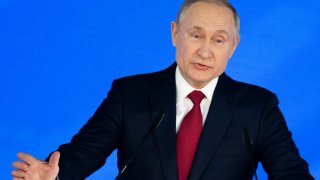
Russian President Vladimir Putin gestures as he addresses the State Council in Moscow, Russia, Wednesday, Jan. 15, 2020. Putin proposed changing the Russian Constitution to increase the powers of parliament and the Cabinet. (AP Photo/Alexander Zemlianichenko)
Russian lawmakers are set to quickly approve the appointment of a new prime minister Thursday, a day after President Vladimir Putin kicked off an unexpected reshuffle of his inner circle that could keep him in power well past the end of his term in 2024.
Mikhail Mishustin, the chief of Russia's tax service, met with lawmakers from various factions in the State Duma ahead of the confirmation vote in the Kremlin-controlled lower house.
Mishustin vowed to focus on social issues and improve living standards.
"We have all the necessary resources to fulfill the goals set by the president," he said. "The president wants the Cabinet to spearhead economic growth and help create new jobs. Raising real incomes is a priority for the government."
Mishustin would succeed Dmitry Medvedev, a Putin associate who was Russia's prime minister for eight years. Medvedev resigned hours after Putin proposed sweeping changes to the constitution.
Medvedev served as president in 2008-2012, keeping the seat warm for Putin who continued calling the shots as prime minister when he was forced to step down from the top job due to term limits. Under Medvedev, the constitution was amended to extend the presidential term from four years to six, although it limits the leader to two consecutive terms.
Putin has kept his longtime ally Medvedev in the Kremlin's leadership structure by appointing him to the newly created post of deputy head of the presidential Security Council.
U.S. & World
The 53-year-old Mishustin is a career bureaucrat who has worked as the tax chief for the past 10 years, keeping a low profile and showing no political ambitions. He has won a good reputation among experts who praised him for boosting tax collection and streamlining Russia's rigid tax administration system.
The reshuffle sent shock waves through Russia's political elites who were left pondering what Putin's intentions were and speculating about future Cabinet appointments.
A constitutional reform that Putin announced in a state-of-the-nation address indicated he was working to carve out a new governing position for himself after his current six-year term ends in 2024, although it remains unclear what specific path he will take to stay in charge.
Putin has been in power longer than any other Russian or Soviet leader since Josef Stalin, who led from 1924 until his death in 1953. Under the current law, Putin must step down when his current term ends.
Putin suggested amending the constitution to allow lawmakers to name prime ministers and Cabinet members. The president currently holds the authority to make those appointments.
At the same time, Putin argued that Russia would not remain stable if it were governed under a parliamentary system. The president should retain the right to dismiss the prime minister and Cabinet ministers, to name top defense and security officials, and to be in charge of the Russian military and law enforcement agencies, he said.
In his address, Putin said the constitution must also specify the authority of the State Council consisting of regional governors and top federal officials.
Observers speculated that Putin might try to stay in charge by shifting into the prime minister's seat again after increasing the powers of parliament and the Cabinet and trimming presidential authority.
Others suggested that he could also try to continue pulling the strings as head of the council and could even shift into a new position before his term ends.
Another potential option is a merger with neighboring Belarus that would create a new position of the head of a new unified state. That prospect that has been rejected by Belarusian President Alexander Lukashenko, an autocratic ruler who has been in power for more than quarter century.
Later on Thursday, Putin is expected to attend a meeting of the working group to draft constitutional amendments.
Putin said that the constitutional changes need to be approved by a public vote, but officials said it doesn't imply a referendum and it wasn't immediately clear how it will be organized.
Daria Litvinova in Moscow contributed to this report.